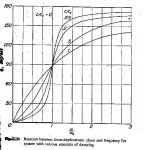And you non technical guys think we are bad!
Coning is the condition where the blades are tilted up from the mast above 90 degrees.
Please don't confuse coning with the dihedral of two wingtip rotors, we'll deal with that when we talk about turning.
Coning results because the blades cannot be infinitely stiff, nor can the hub be infinitely strong. When the blade starts making lift it will climb up until something stops it. The something is generally centrifugal force. Note in the first diagram that the blade force tries to make the blade cone, the centrifugal force tries to make it flat. Hub stiffness affects the coning angle as well. Note that if the hub is stiff that the blade will still bend under load and create coning another way. Failure to allow for coning in a full sized aircraft results in very high hub stresses and early failures.
Airplane wings do the same thing under load, they experience a slight amount of dihedral under load. For very stiff wings this may be measured in the .001" but it still happens. So coning is a direct result of the rotor being loaded.
The question is what are the effects of coning and are they desirable. Coning looks like dihedral in an airplane so it seems that it should do the same thing. However it doesn't.
It's a little sideways to the explanation but lets quickly describe dihedral in a wing. The "v" from dihedral works to stabilize an airplane because when an airplane is disturbed from level flight it tends to slide sideways (slip). The "V" made by the wings geometry forces the wing that is forward in the slip to have a higher angle of attack than the wing that is backwards in the slip. This difference raises the lower, forward slipping wing back to level.
So lets return to a coned rotor in the second figure. The coned rotor is traveling right to left. Note that the two blades at position E, on the left and right sides, have the same angle of attack as they had without coning. It's not that they have the same angle as each other because we know flapping and asymmetric velocity are both affecting each blade differently, but they have the same angle of attack that they would have if not coned. The blades for and aft are a different story. The blade leading is much like the leading wing in a dihedraled plane. If you break down the incoming airflow from aircraft motion (Vf) it has two parts, a part horizontal to the blade (Vh) and a part that is vertical to the blade (Vv). The aft blade has the same Vf but this breaks down, in this case, to a horizontal part and a small negative vertical part. It should be clear that the forward blade has a much higher relative angle attack to its local airflow than the aft blade does. Note that the side blades have the same old angles they had before but the front going blade now goes from zero to some increased angle back to zero at the retreating side. Oh my, we already know what this is, cyclic pitch. So the front blade has increased lift applied to it and 90 degrees later it flaps up and applies that increased lift to the aircraft and the net result is a roll towards the advancing blade.
So this behavior is not very intuitive to the average observer. To see the model pitch up and roll to the advancing side makes no sense until you see the whole combined picture. Making the model move creates asymmetric velocity. Asymmetric velocity causes the rotor to flap back until flapping and/or cyclic stop the flap. Once the rotor is loaded up with the weight of the model at takeoff the rotor cones and promptly rolls to the advancing blade. The problem is that the cone induced roll doesn't happen in your hand, it doesn't kick in until the weight of the model is on the rotor. So in the first case coning is definitely problematic.
How about the similarity to dihedral.
Suppose the model is flying along level. It then gets bumped off to the side. What happens then is one blade is pointed down hill just like the dihedral wing. You used to believe that this would just pick that side of the rotor up, but now you know better. Because the aircraft responds 90 degrees behind the rotor the net effect of the aircraft slipping sideways with coning is that it makes the aircraft pitch, not correct in roll. Worse yet is if the slip is to the advancing blade the pitch is nose up and if the slip is to the retreating blade, the pitch is nose down. So not only does the coning not provide the desired roll correction, it creates a nasty pitch result.
So does coning have to happen, yes. Do we have to allow for it in full sized rotors, yes. Can we ignore it in models with much stronger materials in the hub and blades relatively speaking, yes. Does it stabilize like dihedral, no. Does it create roll coupling with forward flight, yes.
So the idea is to reduce coning.
There are a couple ways, one is to increase the overall rotor stiffness. Another way is to increase the RPM of the rotor (but this increases the following rate, and raises all the stresses on the rotor). Another is to shift the CG of the blade further out so the the centfigual forces are more effective in reducing coning (tip weight).
There you have it. Coning is a necessary evil. It has nasty side effects and is not stabilizing. There are ways to reduce coning, the most common being the use of tip weight.
Source:
http://www.rcgroups.com/forums/showthread.php?t=614030
